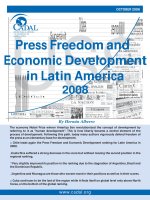Uncharted Waters: Navigating the Social and Economic Context of California’s Budget doc
Bạn đang xem bản rút gọn của tài liệu. Xem và tải ngay bản đầy đủ của tài liệu tại đây (400.77 KB, 71 trang )
1107 9th Street,
Suite 310
Sacramento,
California 95814
(916) 444-0500
www.cbp.org
A PRESENTATION BY
THE CALIFORNIA BUDGET PROJECT
May 2009
Uncharted Waters:
Navigating the Social and Economic Context of
California’s Budget
1
Why Do Budgets Matter?
Nearly three-quarters of every dollar spent through the
state’s General Fund flows to individuals, health providers,
schools, and local governments.
The decisions made in this year’s budget debate affect the
daily lives of all Californians – from the quality of our public
schools to the roads we drive on and the air we breathe.
Many of the decisions made as part of budget deliberations
– such as changes in tax policies, the “base” for the
state’s school funding guarantee, and decisions to place
constitutional limits on the budget and budget process –
will affect Californians for decades into the future.
2
Most State Dollars Go to Local Communities and Individuals
2009-10 Proposed General Fund Spending
State Operations
26.7%
Capital Outlay
0.3%
Local Assistance
72.9%
Note: Excludes unclassified spending.
Source: Department of Finance
3
The Bottom Line
The recent budget agreement addressed a $40 billion budget
shortfall in the remainder of 2008-09 and the 2009-10 fiscal
years.
The shortfall resulted from a deterioration of current and budget
year revenue collections due to a slowing economy, modestly
higher-than-anticipated current-year spending, and a structural
imbalance between the cost of programs and services and the
revenues raised by the state’s tax system.
The budget agreement included $41.6 billion in “solutions” to
close the gap and assumed that the state would end 2009-10
with a $2.0 billion reserve.
4
How Big Is a $40 Billion Budget Gap?
To close the projected $15 billion gap in the remainder of
2008-09 and the $25 billion gap projected for 2009-10
solely through spending cuts is equivalent to:
– Eliminating General Fund support for schools,
community colleges, resources, and environmental
protection programs for the remainder of 2008-09
beginning March 1
st
; and
– Eliminating General Fund support for corrections, CSU,
UC, CalGrants, IHSS, CalWORKs, and SSI/SSP for all of
2009-10.
California's Budget Gap Will Be the Third Largest Among
States With Projected 2009-10 Budget Shortfalls
0%
5%
10%
15%
20%
25%
30%
35%
M
i
s
s
i
s
s
i
p
p
i
W
e
s
t
V
i
rg
i
n
i
a
S
o
u
t
h
D
a
k
o
t
a
A
r
k
a
n
s
a
s
N
e
b
r
a
s
k
a
C
o
l
o
r
a
d
o
M
a
i
n
e
T
e
n
n
e
s
s
e
e
M
i
c
h
i
g
a
n
O
h
i
o
T
e
x
a
s
O
k
l
a
h
o
m
a
V
i
rg
i
n
i
a
S
o
u
t
h
C
a
r
o
l
i
n
a
M
a
s
s
a
c
h
u
s
e
t
t
s
H
a
w
a
i
i
U
t
a
h
I
o
w
a
M
a
ry
l
a
n
d
R
h
o
d
e
I
s
l
a
n
d
I
d
a
h
o
G
e
o
r
g
i
a
D
e
l
a
w
a
re
N
o
r
t
h
C
a
r
o
l
i
n
a
I
l
l
i
n
o
i
s
K
a
n
s
a
s
W
a
s
h
i
n
g
t
o
n
M
i
n
n
e
s
o
t
a
W
i
s
c
o
n
s
i
n
V
e
rm
o
n
t
N
e
w
J
e
rs
e
y
L
o
u
i
s
i
a
n
a
F
l
o
r
i
d
a
C
o
n
n
e
c
t
i
c
u
t
N
e
w
Y
o
r
k
C
a
l
i
f
o
r
n
i
a
A
r
i
z
o
n
a
N
e
v
a
d
a
2009-10 Budget Shortfall as a Percentage of
2008-09 State General Fund Spending
Note: The projected budget gaps for six states are not yet available.
Source: Center for Budget Policy and Priorities
5
6
The Big Picture
The 2008-09 budget crisis was bigger, different, and more
challenging than any that California has faced before. The
2009-10 shortfall was even bigger, more different, and
even more challenging than that of 2008-09 due to the
impact of the recession and the state’s cash flow
problems.
California’s budget problems have been exacerbated by
“solutions” to prior crises that impose future costs,
earmark revenues, and otherwise limit options for
balancing the budget.
7
How Did the Budget Agreement Close the Gap?
The budget agreement closed the gap by:
– Cutting General Fund spending by $15.8 billion;
– Raising revenues by $12.5 billion, primarily through a
temporary 1.0 cent increase in the state’s sales tax
rate;
– Borrowing $5.4 billion, primarily by issuing bonds that
would be repaid out of future lottery proceeds; and
– Using $7.9 billion of funds from the federal economic
recovery bill.
8
How Was the Budget Balanced?
Redirect Prop. 10 and Prop.
63 Funds
2.0%
Federal Economic
Recovery Funds
19.0%
Reduce Proposition 98
Spending
20.3%
Other Health and Human
Services Reductions
1.9%
Public Transit Reductions
1.1%
Other Reductions
4.5%
Higher Education Reductions
3.4%
SSI/SSP Reductions
2.1%
Borrowing
13.0%
State Employee Reductions
2.8%
Increased Taxes
30.1%
Total Solutions = $41.6 Billion
Source: Department of Finance
9
Budget Agreement Includes $12.5 Billion in New Taxes
The increases will be in effect for three to four years if voters approve
Proposition 1A or two years if voters reject the measure. Specifically,
the budget agreement:
– Increases the state sales tax by 1 cent, raising an estimated
$1.203 billion in 2008-09 and $4.553 billion in 2009-10.
– Increases the Vehicle License Fee (VLF) rate from 0.65 percent to
1.15 percent, except for large commercial vehicles, raising
$345.9 million in 2008-09 and $1.692 billion in 2009-10.
– Increases each of the state's personal income tax rates by an
additional 0.25 of a percentage point, raising an estimated $3.658
billion in 2009-10.
– Reduces the size of the dependent credit claimed by personal
income taxpayers to the same level as the personal credit, raising
an estimated $1.440 billion in 2009-10.
Budget Agreement Tax Increases Will Disproportionately Impact Low-Income Taxpayers
0.98%
0.90%
0.87%
0.87%
0.75%
0.57%
0.47%
0.0%
0.2%
0.4%
0.6%
0.8%
1.0%
1.2%
Bottom Fifth Second Fifth Middle Fifth Fourth Fifth Next 15 Percent Next 4 Percent Top 1 Percent
Budget Agreement Tax Increases as a Percentage of 2008 Income
Source: Institute on Taxation and Economic Policy
11
What Were the Deal Points?
In order to achieve the required two-thirds vote for approval of
the tax increase, the budget agreement included:
– A spending cap and modified budget reserve that will go
before the voters as Proposition 1A in May;
– Changes to state environmental, contracting, and labor laws;
– A ballot measure that would prohibit legislative salary
increases in bad budget years that will go before the voters
in May;
– A ballot measure that would create an “open primary” for
state office holders that would go before the voters in June
2010; and
– Three temporary and one very large permanent tax cuts.
12
Seven Measures Are Headed to the Ballot
Six measures will appear on the May 19, 2009 special election ballot:
– Proposition 1A would modify the state’s budget reserve and limit future
spending.
– Proposition 1B would require the state to make $9.3 billion in
supplemental payments to school districts and community colleges in
lieu of what may be owed for “maintenance factor” in 2007-08 and
2008-09.
– Proposition 1C would authorize the sale of bonds backed by lottery
proceeds.
– Proposition 1D would divert funds raised by Proposition 10 of 1998.
– Proposition 1E would divert funds raised by Proposition 63 of 2004.
– Proposition 1F would eliminate salary increases for state elected officials
in years with a projected budget deficit.
The seventh measure would create an “open primary” system which will be
placed on the June 8, 2010 statewide primary ballot.
13
What Impact Will the Ballot Measures Have on the Budget?
Proposition 1A: Has no impact in 2008-09 or 2009-10. Passage
would extend temporary tax increases beginning January 1, 2011 and
would require annual transfers out of the General Fund beginning in
2011-12.
Proposition 1B: Requires payments to education beginning in 2011-
12. The impact relative to current law is unclear.
Proposition 1C: The February budget agreement assumes the sale of
$5 billion of bonds backed by lottery proceeds. Requires the state to
assume additional costs for education beginning in 2009-10.
Proposition 1D: Shifts $608 million to the General Fund in 2009-10,
and $268 million per year for four additional years.
Proposition 1E: Diverts about $230 million per year from mental
health programs to the General Fund in 2009-10 and 2010-11.
14
How Did Things Get So Bad So Fast?
Revenue forecasts for 2007-08, 2008-09, and 2009-10 have
been downgraded by a total of $31.3 billion since the 2008-09
Budget was signed into law in September.
Spending is modestly higher than anticipated due to lower-
than-expected local property tax collections, which boosts the
state’s costs for education; firefighting costs; and caseload-
driven increases in health and human services programs due to
the downturn in the economy.
California faces an ongoing imbalance between revenues and
expenditures that is exacerbated by the state’s past reliance on
one-time “solutions” to balance the budget and by debt service
costs attributable to deficit-related borrowing.
15
Anticipated Revenues Are Down by $31 Billion Since September
($0.5)
($14.5)
($16.3)
($18)
($16)
($14)
($12)
($10)
($8)
($6)
($4)
($2)
$0
2007-08 2008-09 2009-10
Change in Department of Finance Baseline Revenue Forecast Between
the 2008 Budget Act and December 2008 (Dollars in Billions)
Source: Department of Finance
16
The Economy Has Weakened Substantially
Both the state and the nation are in what many economists expect to
be the deepest recession in the post-World War II era. The recession,
which began in late 2007, has led to substantial job losses, a sharp
rise in unemployment, and a drop in consumer spending.
– California’s job losses accelerated in late 2008 and early 2009.
Between March 2008 and March 2009, California lost 637,400
nonfarm jobs, a 4.2 percent decline.
– California’s unemployment rate hit 11.2 percent in March 2009,
up from 6.4 percent in March 2008, and new unemployment
insurance claims spiked by 62.4 percent during this period.
– National personal consumption spending dropped by 4.3 percent
in the fourth quarter of 2008 – the largest decline since 1980.
– California’s median home price plunged from a peak of $484,000
in the spring of 2007 to $223,000 in March 2009.
California's Job Losses Continued in Early 2009
-4.2%
2.1%
-4.5%
-4.0%
-3.5%
-3.0%
-2.5%
-2.0%
-1.5%
-1.0%
-0.5%
0.0%
0.5%
1.0%
1.5%
2.0%
2.5%
Jan-06
Feb-
0
6
Ma
r-0
6
A
p
r-
06
Ma
y
-06
Jun-06
Jul-06
A
u
g-
0
6
Sep-06
Oct-06
Nov-0
6
Dec-06
J
a
n-0
7
Fe
b
-07
Mar-07
A
p
r
-07
Ma
y-0
7
Jun-
07
Jul-07
A
u
g
-07
S
e
p
-
07
Oc
t-
0
7
No
v-
07
De
c
-
07
Jan-08
Feb-08
Ma
r-0
8
A
p
r-
0
8
Ma
y
-08
Jun-08
Jul-08
Aug-08
Sep-0
8
Oct-08
Nov-0
8
Dec-08
J
a
n-0
9
Fe
b-
09
Ma
r-09
Percent Change in the Seasonally Adjusted Number of
Nonfarm Jobs From Same Month of the Prior Year
Source: Employment Development Departmen
t
17
New Unemployment Insurance Claims Have Spiked Over the Past Year
6.9%
6.8%
-3.8%
-9.2%
-7.0%
-5.8%
-2.2%
10.4%
62.4%
-20%
-10%
0%
10%
20%
30%
40%
50%
60%
70%
2001 2002 2003 2004 2005 2006 2007 2008 2009
Year-Over-Year Percent Change in the Number of
March Initial Claims for Unemployment Insurance
Source: US Employment and Training Administration
18
Personal Consumption Spending Fell in the Fourth Quarter of 2008 by the Largest Percentage Since 1980
-4.3%
-5%
-4%
-3%
-2%
-1%
0%
1%
2%
3%
4%
5%
Q1 2006 Q2 2006 Q3 2006 Q4 2006 Q1 2007 Q2 2007 Q3 2007 Q4 2007 Q1 2008 Q2 2008 Q3 2008 Q4 2008
Quarter
Annual Rate of Change in Inflation-Adjusted and
Seasonally Adjusted Personal Consumption Expenditures
Source: US Bureau of Economic Analysis
19
California's Median Home Price Has Plunged Since Peaking in Spring 2007
$223,000
$178,000
$484,000
$0
$50,000
$100,000
$150,000
$200,000
$250,000
$300,000
$350,000
$400,000
$450,000
$500,000
$550,000
Ma
r-89
Ma
r-9
0
Ma
r-
91
Ma
r-
92
Mar-93
Mar-94
Mar-95
Mar-96
Ma
r-97
Ma
r-98
Ma
r-99
Ma
r-00
Ma
r-0
1
Ma
r-0
2
Ma
r-
03
Mar-04
Mar-05
Mar-06
Mar-07
Mar-08
Ma
r-09
Monthly Median Price for Homes Sold in California
Note: Includes new and resale condominiums and single-family detached homes.
Source: MDA DataQuic
k
20
21
Demand for Services Rises as Economic Conditions Worsen
Between December 2007 and December 2008, the number of
Californians receiving food stamps increased by 17.2 percent
(370,284), more than twice the increase during the prior year
(6.2 percent).
Between January 2008 and January 2009, the number of
children enrolled in the Healthy Families Program increased by
5.5 percent (46,811), following an 8.3 percent increase (64,539)
during the prior year.
Between November 2007 and November 2008, the number of
families receiving CalWORKs cash assistance increased by 6.6
percent (30,475), a 16-fold increase over the previous year
when the number of families increased by 0.4 percent (1,935).
22
The Number of Californians Receiving Food Stamp Benefits Has Risen Substantially
2,528,500
2,158,216
1,900,000
2,000,000
2,100,000
2,200,000
2,300,000
2,400,000
2,500,000
2,600,000
D
ec-06
Jan-
0
7
Feb-07
M
ar-
0
7
A
pr
-
07
M
ay
-
07
Jun-07
Jul-
07
A
ug-07
S
ep-
07
O
ct-07
N
ov-
07
D
ec-07
Jan-
0
8
Feb-08
M
ar-
0
8
A
pr
-
08
M
ay
-
08
Jun-08
Jul-
08
A
ug-08
S
ep-
08
O
ct-08
N
ov-
08
D
ec-08
Number of Californians Receiving Food Stamp Benefits
Source: Department of Social Services
23
The Number of Families Receiving CalWORKs Cash Assistance Has Increased Since July 2007
400,000
500,000
600,000
700,000
800,000
900,000
1,000,000
N
ov-
90
N
ov-
91
N
ov-
92
N
ov-
93
N
ov-
94
N
ov-
95
N
ov-
96
N
ov-
97
N
ov-
98
N
ov-
99
N
ov-
00
N
ov-
01
N
ov-
02
N
ov-
03
N
ov-
04
N
ov-
05
N
ov-
06
N
ov-
07
N
ov-
08
Number of Families Receiving AFDC/CalWORKs Cash Assistance
Source: De
p
artment of Social Services
Caseload peak (March 1995)
Federal welfare law enacted (August 1996)
CalWORKs implementation
begins (January 1998)
Previous national recession
ends (November 2001)
Current national recession
begins (December 2007)
24
The Long-Term Roots of the Crisis
Tax cuts enacted between 1993 and 2008 cost the state
nearly $12 billion in 2008-09. The largest of these – the
reduction in Vehicle License Fees – shows up in the budget
as a spending increase, distorting the true balance
between revenues and expenditures.
Voter-approved bonds and earmarked spending limit
policymakers’ ability to balance the budget. The state’s
debt service costs as a percentage of spending have more
than doubled since 2002-03.









